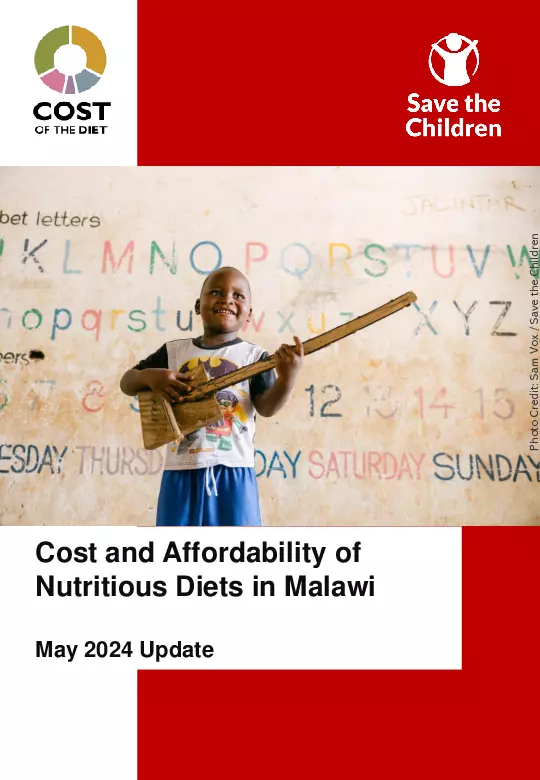
Reports, Study: Research
Cost and Affordability of Nutritious Diets in Malawi: Updates
Publication year:
2024
English
Format:
PDF (2.6 MiB)
Publisher:
Save the Children International,Save the Children Malawi
Save the Children (SC) in Malawi has been monitoring the monthly household cost of a nutritious diet and assessing affordability gaps across various household types since April 2021 using the Cost of the Diet (CotD) assessment research method. The objective of this ongoing assessment is to estimate trends in the minimum cost and affordability of a nutritious diet in Malawi and to integrate SC’s Household Economy Analysis (HEA) with CotD tools to forecast future changes in diet affordability. The goal is to pre-emptively model interventions to prevent a decline in the affordability of nutritious diets, thereby averting an increase in malnutrition.
This study analysed the monthly prices of 29 essential food items across 77 markets in 25 districts from April 2021 to February 2024. The food items include grains, roots, legumes, fish, chicken eggs, vegetables, oil, and sugar, with data obtained from the Minimum Expenditure Basket (MEB) provided by the World Food Programme (WFP).
Key findings indicate significant price increases: maize surged by 503%, rice by 205%, and cassava by 298%. Household energy costs rose 4.6 times, and the monthly cost of the Food Habits Nutritious (FHAB) diet for a standard five-person household increased by 210%. By February 2024, the FHAB diet was 3.1 times more expensive than in April 2021.
The affordability gap widened consistently, with the gap for an average Malawian household growing from 6,000 kwachas in April 2021 to 127,000 kwachas by February 2024. For ultra-poor, poor, rural, and average households, the affordability gaps surged to 217%, 127%, 121%, and 82%, respectively.
During the first 1000 days of life, the cost and affordability of the diet witnessed a notable change. Despite an increase in income for mother-child pairs from MWK 31,242 to MWK 38,122 between April 2021 and February 2024, the affordability gap doubled from MWK 7,742 to MWK 14,579 over the same period.
Predictive analysis for 2024-25 forecasts maize prices rising by 52% annually, with beans, oil, and dried fish increasing by 31%, 24%, and 19%, respectively. Modelling anticipatory actions, such as cash support and agricultural inputs, shows significant potential to reduce the affordability gap. Implementing a comprehensive package of support could reduce the annual affordability gap for poor households to 307,000 kwachas.
This ongoing research highlights the urgent need for targeted interventions to ensure the affordability of nutritious diets in Malawi, aiming to prevent increased malnutrition rates due to economic challenges.
Read full abstract
Authors
View & Download
English
2 Documents
Document information
Authors
Format
Content type
Country
Region
Topics
Rights
© Author/Publisher
Found a mistake? Help us improve!
If you have noticed a document assigned to the wrong author or any other inaccuracies, let us know! Your feedback helps us keep our data accurate and useful for everyone.
Share
Link

